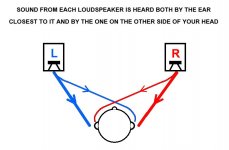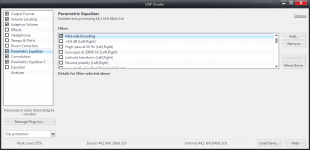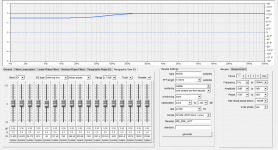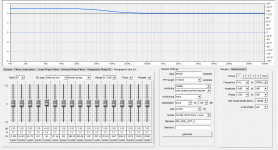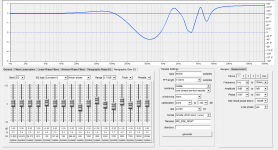Byrtt thanks for thinking of me but I doubt I will get the chance.
I would say if you have the time still try it on the mono speaker, the effect would likely be much more subtle but interesting to see if you hear it that way. Insert it in the stereo path before summing to mono.
This will likely have no positive effect on a single speaker. It still is based on this:
I'd say it works best for a standard stereo setup. It has little to do with fake surround though. All it does is even out the perceived balance at the ears, making it that little bit closer to what one would hear on headphones. Softening some of the effects of cross talk.
Attachments
This will likely have no positive effect on a single speaker.
I'd still be interested to find out what the effect is unless Byrtt thinks it's a waste of his time, which it probably is
I couldn't think of a single reason to do so  . But if he's willing to try...
. But if he's willing to try...
I came up with it by measuring in my room with pieces of wire, turning it into a drawing and then verifying the dips trough tests with mixed stereo files. you'd simply need the two sources as they combine at the ears.
Listening to the tests to verify the exact frequencies I needed had a very interesting effect for the phantom center. One that makes me think Prof. Edgar Choueiri's setup would be very intriguing to hear.
I came up with it by measuring in my room with pieces of wire, turning it into a drawing and then verifying the dips trough tests with mixed stereo files. you'd simply need the two sources as they combine at the ears.
Listening to the tests to verify the exact frequencies I needed had a very interesting effect for the phantom center. One that makes me think Prof. Edgar Choueiri's setup would be very intriguing to hear.
Last edited:
Curiosity?I couldn't think of a single reason to do so
Probably work better if you stood it up on end and used one each sideMaybe an extra long horizontal sound bar looks like an extra long vertical line array? It's easy to mix them up!
If you PM your email address I'll send you the preset to save typing them all in manuallyI'll try your mid/side tweaks tomorrow morning, which is my window of quiet this week. I also have the FabFilter plugin, so, it should be straight forward.
Maybe an extra long horizontal sound bar looks like an extra long vertical line array? It's easy to mix them up!
I'll try your mid/side tweaks tomorrow morning, which is my window of quiet this week. I also have the FabFilter plugin, so, it should be straight forward.
Be prepared to have something like this in your listening chain forever
Be prepared to have something like this in your listening chain forever.
Tomorrow then! Sounds exciting!
No problem, but it's really not mine, these are wesayso's settings he did all the hard work testing them.Fluid, thanks for posting your M/S EQ. I'm intrigued because it looks like almost the opposite of what I would do. What you've done to the mid is what I would do to the sides - so I'm a little perplexed!
Why would you apply the EQ to the sides? The idea is to clean up the centre a bit so it makes sense to me to apply it mainly to the mid signal.
It came out of wesayso using your phase shuffler but struggling to get the balance right with it in.
It would be easy enough to flip the EQ around but it doesn't make any sense to me. Easy enough to try though.
Fab Filter Pro Q Mid Side Preset
Attached, the relative level is is set by the pan control between 0.5 to 1dB either way seems the best range. I imagine you will be like me and drop the sides a little due to being in a reflective environment. If you don't have volume levelling on you might want to lower the gain by a dB or so to avoid any possible clipping.
Let us know what you think
fluid,
you know you could zip the preset and attach it to a post?
Attached, the relative level is is set by the pan control between 0.5 to 1dB either way seems the best range. I imagine you will be like me and drop the sides a little due to being in a reflective environment. If you don't have volume levelling on you might want to lower the gain by a dB or so to avoid any possible clipping.
Tomorrow then! Sounds exciting!
Let us know what you think
Attachments
Good you should ask. The reason I found the shuffler in the first place was because I heard the side channels as too bright compared to the phantom center. My original idea was M/S EQ, but I used the shuffler instead as it seemed easier.Why would you apply the EQ to the sides? The idea is to clean up the centre a bit so it makes sense to me to apply it mainly to the mid signal.
For me, a well tuned system with a ratio of more direct sound than reverberant has the funny problem of the sounds in 1 speaker only being brighter than the sounds in 2 speakers. I learned that it is the phantom center "speaker" that is darker in tone because of head shadowing. But I didn't want to change the center EQ, that sounded good to me, I just wanted to make the sides less bright when they played alone. An overall change isn't wanted, just a darker sound on hard left or right sounds.
The EQ that I see on your middle channel is close to the mid dips that the phantom center already has. It's the sides that I'd want to pull some midrange out of, because they sound too bright compared to the center. But your EQ isn't exactly the same, so perhaps it's doing things to the middle that I'm not understanding by just looking at it.
The list of EQ tweaks I send to fluid were the easiest way to implement them. If we setup a system where we have to "paint" the FR ourselves, the side actually is easier to setup. As it will be a more "straight line" like target.
It's the center that's more difficult, yet that's the one we most commonly hear above all else.
The dips in the EQ scheme posted line up where the energy of the left speaker in the right ear sums with the right speaker's direct output and vice versa. At least it does with my average head size .
.
That sum looks like this:

In this graph there's the sum of both left and right channel at each ear,
compared to what one ear would hear from one speaker. It's happening at both ears though. No regards for things like head shading in this model.
Another view as a waterfall plot:

This is the peaks and dips (comb pattern) that happen at each ear for phantom center material. That means double trouble.
As it would be impossible to EQ out the dips (without phase tricks). Introducing more energy at for example 1750 Hz would also create a bigger dip at the ear due to both arrivals, one directly from the speaker to the closest ear and the other part being the wrap around the head with a delay from the opposite side, subtract instead of sum at that frequency.
So the next best thing is to EQ down the peaks they create. Though we have to keep head shading in mind. That resulted in the list of EQ cuts fluid posted, after many hours of testing.
The end result did sound way more similar in the center to what an ideal side or a single mono speaker would sound like. The starting point here is a good FR curve for the side material. One could even play one speaker and adjust the FR curve to taste on that with mono material. As that would be very similar.
There's hardly anyone that will claim a straight frequency curve sounds just right (yes, I know, they do excist). The EQ cuts at the phantom center are my suggestions to that problem. However the sides will most probably sound way more right with that straight FR target(*). As they do not suffer from cross talk.
(*) = With a straight curve I do reserve to make that a downwards slope for a listening spot measurement, just want to mention this part.
These suggestions do what you'd want to achieve. Its just taking the side balance as a starting point as that's how we approached the preliminary target in fluid's case. Drawing a straight line that drops 1 dB per octave and go from there.
So anyone testing this might start with a more ideal curve, not yet set or EQ-ed to taste. After mid/side EQ is a part of the chain, one can fine tune the balance to find the best target curve. These settings are nothing more and nothing less than the difference in balance between the two (phantom center and sides).
It's the center that's more difficult, yet that's the one we most commonly hear above all else.
The dips in the EQ scheme posted line up where the energy of the left speaker in the right ear sums with the right speaker's direct output and vice versa. At least it does with my average head size
That sum looks like this:

In this graph there's the sum of both left and right channel at each ear,
compared to what one ear would hear from one speaker. It's happening at both ears though. No regards for things like head shading in this model.
Another view as a waterfall plot:

This is the peaks and dips (comb pattern) that happen at each ear for phantom center material. That means double trouble.
As it would be impossible to EQ out the dips (without phase tricks). Introducing more energy at for example 1750 Hz would also create a bigger dip at the ear due to both arrivals, one directly from the speaker to the closest ear and the other part being the wrap around the head with a delay from the opposite side, subtract instead of sum at that frequency.
So the next best thing is to EQ down the peaks they create. Though we have to keep head shading in mind. That resulted in the list of EQ cuts fluid posted, after many hours of testing.
The end result did sound way more similar in the center to what an ideal side or a single mono speaker would sound like. The starting point here is a good FR curve for the side material. One could even play one speaker and adjust the FR curve to taste on that with mono material. As that would be very similar.
There's hardly anyone that will claim a straight frequency curve sounds just right (yes, I know, they do excist). The EQ cuts at the phantom center are my suggestions to that problem. However the sides will most probably sound way more right with that straight FR target(*). As they do not suffer from cross talk.
(*) = With a straight curve I do reserve to make that a downwards slope for a listening spot measurement, just want to mention this part.
These suggestions do what you'd want to achieve. Its just taking the side balance as a starting point as that's how we approached the preliminary target in fluid's case. Drawing a straight line that drops 1 dB per octave and go from there.
So anyone testing this might start with a more ideal curve, not yet set or EQ-ed to taste. After mid/side EQ is a part of the chain, one can fine tune the balance to find the best target curve. These settings are nothing more and nothing less than the difference in balance between the two (phantom center and sides).
A second part which would result in an improvement to the above tweaks is to add ambient channels as they can fill in the dip at ~1750 Hz. As the ears have a different comb pattern for sounds that come from a lateral angle (trying to find the reverence in the work of Griesinger for more information on that, he provided graphs for this in one of his papers) it can be used to make the perceived tonality even better.
This trick alone is pretty good though, more than "just" pretty good for me. It gives balance between center and sides and more "balls" to the sides than I've ever had before, as we tend to always focus on that phantom center to tune it to our wishes.
More than highly recommended by me!
This trick alone is pretty good though, more than "just" pretty good for me. It gives balance between center and sides and more "balls" to the sides than I've ever had before, as we tend to always focus on that phantom center to tune it to our wishes.
More than highly recommended by me!
Good you should ask. The reason I found the shuffler in the first place was because I heard the side channels as too bright compared to the phantom center. My original idea was M/S EQ, but I used the shuffler instead as it seemed easier.
For me, a well tuned system with a ratio of more direct sound than reverberant has the funny problem of the sounds in 1 speaker only being brighter than the sounds in 2 speakers.
For me I was still playing with overall EQ targets when I introduced it at wesayso's suggestion. I noticed a fairly obvious change for the better. I wasn't looking to fix a problem like in your case but applying the EQ did make almost everything sound better and I couldn't find anything that sounded worse.
The difference between this EQ on and off has mellowed a little over time for me as I have been tweaking the EQ balance overall. It really did make the biggest difference with a 1dB/oct overall fall to the FR.
Wesayso has been along to give his reasoning, the pattern is certainly similar to your shuffler but I think the frequencies are different, I'm not an expert on either so I could be wrong
I drop the level of the sides slightly as I find them to be too prominent with the EQ in place so perhaps it could work for you, and it is easy to change to taste based on the relative mid side levels.
It would be great if you could try it and see what you think, whether it helps with your brighter sides issue or if it just sounds better, or not.
Mid Side EQ
For fluids curiosity even my system is stereo signal feeded mono speaker tried Mid Side EQ onboard player computer
From my listening position in front this player computer enable/disable filters was not success sound wise but please check below if there is any mistakes to point out in setup chain, also myself had no high hope in it would work good because this speaker by itself has enorm high intelligibility and also its sound signature can remind one of sound in wesayso's living room, not that i had special tweaked it to copy wesayso's performance it just did it by itself as correction tweaks over time got acoustics performance more and more in line with same pass-band executed as synthetic impulse response.
To do it for free without having to invest in various hardcore VST plugins tried use JRivers build in Mid-side Encoding in first PEQ container then Rephase created linear phase EQ loaded in JRivers convolution container and in second PEQ container loaded Mid-side Decoding. Chain can be seen in first picture below and hope i did it right in expect that after encoding filter Mid-CH is now right-CH revealed by "Analyzer" show right-CH to be the loudest, so Side must be left-CH.
Second picture below is linear phase filter for Side-EQ loaded via config-file in convolution container to left-CH -0,5dB as fluid use, and third picture is second choise to hear how +0,5dB sounds as wesayso use.
Fourth picture below is linear phase filter for Mid-EQ loaded via config-file in convolution container to Right-CH. Have a feeling looking at fluids visual fabfilter in post 790 that there could be a little mistake in printed numbers for first filter which says "100Hz Q 0.5 Gain 0.5", shouldn't it had been a low shelve instead of PEQ ???
Down the road when i get stereo speaker setup again will run into HRTF trouble and then will try this guide and filters again
For fluids curiosity even my system is stereo signal feeded mono speaker tried Mid Side EQ onboard player computer
From my listening position in front this player computer enable/disable filters was not success sound wise but please check below if there is any mistakes to point out in setup chain, also myself had no high hope in it would work good because this speaker by itself has enorm high intelligibility and also its sound signature can remind one of sound in wesayso's living room, not that i had special tweaked it to copy wesayso's performance it just did it by itself as correction tweaks over time got acoustics performance more and more in line with same pass-band executed as synthetic impulse response.
To do it for free without having to invest in various hardcore VST plugins tried use JRivers build in Mid-side Encoding in first PEQ container then Rephase created linear phase EQ loaded in JRivers convolution container and in second PEQ container loaded Mid-side Decoding. Chain can be seen in first picture below and hope i did it right in expect that after encoding filter Mid-CH is now right-CH revealed by "Analyzer" show right-CH to be the loudest, so Side must be left-CH.
Second picture below is linear phase filter for Side-EQ loaded via config-file in convolution container to left-CH -0,5dB as fluid use, and third picture is second choise to hear how +0,5dB sounds as wesayso use.
Fourth picture below is linear phase filter for Mid-EQ loaded via config-file in convolution container to Right-CH. Have a feeling looking at fluids visual fabfilter in post 790 that there could be a little mistake in printed numbers for first filter which says "100Hz Q 0.5 Gain 0.5", shouldn't it had been a low shelve instead of PEQ ???
Down the road when i get stereo speaker setup again will run into HRTF trouble and then will try this guide and filters again
Attachments
Hi Byrtt,
Thanks for trying, it is hard to say from that whether you have it right, the graphs scales are so different and there is the question of the mid side process.
And no it was not a mistake it is 100Hz Q0.5 Gain 0.5 PEQ in my settings.
There are only two shelving filters, the low one in the side channel and the High one in the Mid.
Coud you run a Dirac Pulse through Jriver with the processing in place and nothing else and use Disk Writer as the output to compare if I do the same?
Whilst I don't think it will make a difference as your setup is not really designed for it, it would be good to know we are using the same settings when comparing.
I am sending you an email with something to try which will make sure we have the same
Thanks for trying, it is hard to say from that whether you have it right, the graphs scales are so different and there is the question of the mid side process.
And no it was not a mistake it is 100Hz Q0.5 Gain 0.5 PEQ in my settings.
There are only two shelving filters, the low one in the side channel and the High one in the Mid.
Coud you run a Dirac Pulse through Jriver with the processing in place and nothing else and use Disk Writer as the output to compare if I do the same?
Whilst I don't think it will make a difference as your setup is not really designed for it, it would be good to know we are using the same settings when comparing.
I am sending you an email with something to try which will make sure we have the same
It's on page 26 of SS vol. 7 catolog I revieced in the mail. Alpha Cenima Grande. Thing is pretty cute build but judging by the relative tweeter diameter the woofers are undersized for use without a sub, but likely adequate for 80Hz xover.Alpha Cinema Grand | Parts Express Project Gallery
It's just one of the posters mentioned setting up a middle speaker to kill the phantom center, or something. Either that or I misinterpreted "design a custom eq for the mids." Perhaps I thought literally a middle speaker was involved instead of mid tonal range.
I'm currently building a pair of Tritrix TLs from PE as I've pretty much abandoned the idea of building a line array when I found out how much work they are, not only to build but to tweak the sound with custom eq. Then room treatments, yada-yada...
I want something to plug into a basic two channel reciever and be done with, but have been enjoying following the build process. FYI, the Tritrix kit is coming along nicely. I assembled and tested the crossovers (with naked drivers) labor day weekend, then built one cabinet the following sunday and the second cabinet this past sunday. Sand/paint the cabs this weekend, install the drivers weekend after. Job sucks. No free time for hobbies.
It's just one of the posters mentioned setting up a middle speaker to kill the phantom center, or something. Either that or I misinterpreted "design a custom eq for the mids." Perhaps I thought literally a middle speaker was involved instead of mid tonal range.
I'm currently building a pair of Tritrix TLs from PE as I've pretty much abandoned the idea of building a line array when I found out how much work they are, not only to build but to tweak the sound with custom eq. Then room treatments, yada-yada...
I want something to plug into a basic two channel reciever and be done with, but have been enjoying following the build process. FYI, the Tritrix kit is coming along nicely. I assembled and tested the crossovers (with naked drivers) labor day weekend, then built one cabinet the following sunday and the second cabinet this past sunday. Sand/paint the cabs this weekend, install the drivers weekend after. Job sucks. No free time for hobbies.
Last edited:
Ok, I had a short listening session with 5 songs I like to listen to.
Turning on/off the Mid/Side preset had some effects indeed.
My OB speakers are insane at creating the ambiance of the room where the recording was made. I can hear if a small studio was used, or a bigger one, just by listening to the reflections in the recording. I can "hear" the room where the microphone was. When a recording was made in a church, I'm in that church when I listen to it.
When my OBs play, the stage expand a good couple of meters outside the physical position of the speakers.
Using the M/S preset, the stage was brought back to the width of the speakers, not extending past them. Also, the room the recording was made in, is subdued and almost gone. Vocals are indeed straight in the middle, with no echoes from the recorded room, so, to my ears used to my setup, it feels strange and a bit lifeless. The feeling of "being there" is lost a bit.
True, it does bring clarity to the center, and I see why on a system using phantom centre channel, it would make dialogues a lot clearer.
For movies, I have a true 5.2 setup, with a centre channel, so I will prefer to have the expanded sound without the M/S preset overall.
I will keep the preset and use it when I watch TV shows using only 2.0, because I sometimes have trouble getting clear dialogues when in 2.0. So, thanks for that.
But for 2.0 music, I think I will keep my own setup.
Thank you very much for the opportunity to try something different.guys! I appreciate it.
Thanks for sharing.
Turning on/off the Mid/Side preset had some effects indeed.
My OB speakers are insane at creating the ambiance of the room where the recording was made. I can hear if a small studio was used, or a bigger one, just by listening to the reflections in the recording. I can "hear" the room where the microphone was. When a recording was made in a church, I'm in that church when I listen to it.
When my OBs play, the stage expand a good couple of meters outside the physical position of the speakers.
Using the M/S preset, the stage was brought back to the width of the speakers, not extending past them. Also, the room the recording was made in, is subdued and almost gone. Vocals are indeed straight in the middle, with no echoes from the recorded room, so, to my ears used to my setup, it feels strange and a bit lifeless. The feeling of "being there" is lost a bit.
True, it does bring clarity to the center, and I see why on a system using phantom centre channel, it would make dialogues a lot clearer.
For movies, I have a true 5.2 setup, with a centre channel, so I will prefer to have the expanded sound without the M/S preset overall.
I will keep the preset and use it when I watch TV shows using only 2.0, because I sometimes have trouble getting clear dialogues when in 2.0. So, thanks for that.
But for 2.0 music, I think I will keep my own setup.
Thank you very much for the opportunity to try something different.guys! I appreciate it.
Thanks for sharing.
Interesting Perceval thanks for trying. I don't hear any of that myself but it is good to hear what it does on different systems.
Did you try to change the levels at all by using the pan pot? Did that have any effect on the things it took away for you?
Also did you test by switching the EQ from Linear phase to Minimum phase in Fab Filter and notice quite a difference? Better with linear phase?
My original reason for posting it was due to the idea some people have that phase changes are inaudible always. For me this demonstrates quite well that they are.
Did you try to change the levels at all by using the pan pot? Did that have any effect on the things it took away for you?
Also did you test by switching the EQ from Linear phase to Minimum phase in Fab Filter and notice quite a difference? Better with linear phase?
My original reason for posting it was due to the idea some people have that phase changes are inaudible always. For me this demonstrates quite well that they are.
- Home
- Loudspeakers
- Full Range
- Full Range TC9 Line Array CNC Cabinet
